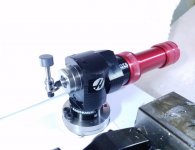corednc
Aluminum
- Joined
- Sep 3, 2019
- Location
- East Coast
Visited a friends shop in late 2019 and saw all the 1/2 AA batteries from their probes that they discard in a year. They get approx 6 months out of a pair and less if the machine is lights out (more tool probing). With 48 mills they go through about 250 batteries a year on just the table probes alone.
This seemed like a waste of money, material, etc. so I created a rechargeable battery system for the 1/2 AA OTS probes. It screws into the back of the OTS probe in place of the battery cover and provides power via a single rechargeable li-ion battery. You should see no difference in use from the 1/2 AA batteries, it even signals the probe when the battery is low so that the low battery lights on the OTS and OMI/OMM work as they should. If you forget to charge the battery in time, 10 minutes on a charger and you are good to go for the rest of the day and maybe more, no more scrambling to overnight ship a few batteries with a machine down.
I have a few beta units remaining so let me know if you are interested. Please note that the beta units that remain have some cosmetic issues (spots on the anodizing and things like that) but they are all fully functional, batteries included.

This seemed like a waste of money, material, etc. so I created a rechargeable battery system for the 1/2 AA OTS probes. It screws into the back of the OTS probe in place of the battery cover and provides power via a single rechargeable li-ion battery. You should see no difference in use from the 1/2 AA batteries, it even signals the probe when the battery is low so that the low battery lights on the OTS and OMI/OMM work as they should. If you forget to charge the battery in time, 10 minutes on a charger and you are good to go for the rest of the day and maybe more, no more scrambling to overnight ship a few batteries with a machine down.
I have a few beta units remaining so let me know if you are interested. Please note that the beta units that remain have some cosmetic issues (spots on the anodizing and things like that) but they are all fully functional, batteries included.








